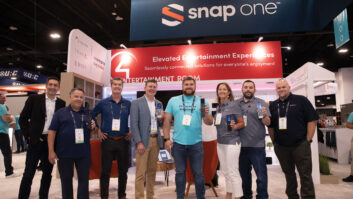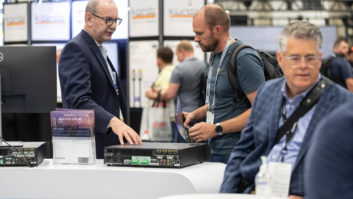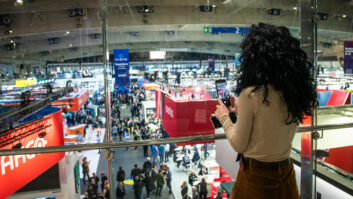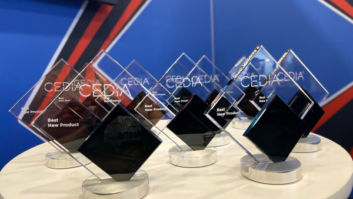It often seems that the media is obsessed with the intersection of time, dates, and numbers. Hardly a newscast, website story, newspaper article, or

magazine feature is written without noting the so-and-so anniversary of this or so many years since that. Indeed, one of our personal favorites, MSNBCs Countdown, uses numerical ranking of stories as the conceit of the whole program.
Lest you think that here at Residential Systems were immune to this trend, think again! It is worth acknowledging that were now three-quarters of the way through the year, and as you read this you about are about to attend, are attending, or have just returned from the 19th Annual CEDIA EXPO. As this is written in mid-August, we cant say for certain what new and exciting products will be shown there, but we can go by the numbers, and point out some things to look for.
3-D Developments
Indeed, numbers are at the heart of more than a few things to look for as you plan your visit to EXPO or review the merits of what you have seen there. As an example, it is likely that well see more than one display manufacturer touting the capabilities of their displays for 3-D video. Its a fair bet that DLP will once again point to 3-D compatibility but what about flat-panel

EXPO will be a good place to keep a sharp eye out for FPD mounting systems, such as Peerless’ Slimline universal mounting solution at only 0.4 inches thin, to accommodate these flush mount designs.technologies? The question is really how many different 3-D technology approaches will appear, and which one(s) will prevail. Beyond the display technology, for 3-D to reach critical mass it needs a significant backlog of content, and while the studios are stepping up the amount of 3-D titles, when will there be enough in the bank to make it worth placing a bet on 3-D as a go-to-market product for the custom and broader consumer video worlds?
Flat-Panel Depth
Another product category where a number is key is in the description of the depth of a flat-panel display, be it LCD or plasma. Thin was definitely in at CES, but one must always remember that it is not just the depth of the panel itself that counts, but the total space footprint of the display, including the stand or wall mount. EXPO will be a good place to keep a sharp eye out on the world of FPD mounting systems to see if and how the various manufacturers re-engineer their products to accommodate the requirements of these new thin panels while, at the same time, we look to see how thin they will get, and when these products will actually be available.
Race for Largest Panel

Thin was in during CES, and CEDIA will likely be home of many introductions like this Hitachi UltraThin 1.5 HDTV LCD Monitor.EXPO will be the place to look for the latest state of the mine is bigger than yours race when it comes to panel size. Panasonic has done a masterful job of promoting and selling its 103-inch-wide plasma display. Now that Sharps 108-inch-wide LCD has an actual market price, albeit one that is an order of magnitude larger than the Panasonic, will having the bragging rights to this is the largest panel you can buy have some traction with clients? Will Panasonic fight back with an announcement of pricing and availability for its extraordinary 150-inch PDP shown at CES, but not seen since? If nothing else, it will be interesting to see what price that set would command.
Additional Screen Sizes
Among the other numerically oriented things to look for at CEDIA EXPO will be the availability of additional screen size options in either plasma or LCD. Its not likely, since the mass market drives this, along with the efficiencies of the panel manufacturers, but you never know. Similarly, will there be any increase in the number of brands offering commercially available OLED displays, and will their size increase above the 11-inch-wide unit offered by Sony, currently the only OLED you can buy outside of a portable product or automotive head unit.
How Many Rear-Pros Remain?
Likely to remain stable is the number of main-line brands offering rear-screen projectors. It is unlikely that those who have dropped out will return, and the two main brands still committed to the category are unlikely to give up at this time. In the RPTV arena, it will be interesting to see what announcements Mitsubishi has for its laser-illuminated DLP set. Will it be available at all before the end of the year, and if so at what screen size and price? We may have some more hints on that score in Denver.
Pico Projector Developments

Optoma’s Pico projectorAt the other end of the spectrum, small-sized pico projectors were previewed at both SID and Infocomm. Although the applications for these tiny wonders in the consumer and customer markets is still to be decided by you, as the people who actually design and install systems, it will be interesting to see if the likes of 3M and Optoma bring the samples theyve shown elsewhere to Denver.
Blu-ray Pricing
CEDIA EXPO will also be a good place to take note of where the market is going in terms of Blu-ray players. Having extinguished HD-DVD as a competitor at the beginning of the year, the Blu-ray brands are now left to make their numbers in terms of delivering sufficient quantities of players to meet consumer demands. While it is too early to tell how far under $299 Blu-ray players will priced on Black Friday to start the consumer holiday selling season, the question for the specialist dealer and custom installer is not how low mass market pricing will go, but what will be available in terms of upscale, high-feature products to allow us to compete with commodity models and house brands and entries from second and third tier branded products.

EXPO will be a defining line in the sand for several aspects of the Blu-ray technology.
One way the differentiation will possibly happen is through sheltered brand models, as well as with mainstream product that offers the full implementation of Profile 2.0 and BD Live interactivity. Will the select distribution brands the custom world is accustomed to selling finally begin to offer Blu-ray players, or is the technology still too new and complex for them to get into production in this year. EXPO will be a defining line in the sand for that aspect of the Blu-ray.
High-end Differentiators
In a similar vein, now that 1080p capability has crept down into mass market video displays, what other numbers will be available to separate high-end, higher priced, video display hardware from what your clients see in the ads, in

A display technology that many installers have successfully employed to distance themselves from “off-the-shelf” products is the installation of 2.35:1 front-projection systems, like the CinemaWide with AutoScope line from Runco. big-box chains, and in the warehouse stores? Thin displays are certainly one way, as mentioned above. Another display technology that many installers have successfully employed to distance themselves from more traditional, off-the-shelf products is the installation of 2.35:1, anamorphic, true wide-screen, scope front-projection systems. Is this is just a passing fad, is it something limited to exotic high-end dedicated theaters, or is it on the cusp of becoming a viable element of home theater design across a broader range of price and installation situations? What new products will be shown at CEDIA EXPO to simplify this type of display or make it more affordable, without diluting its value and place as something that a client can get only from a custom installer?
Tracking HDMI
Another set of numbers that might set things apart are 1.3 and 12. The former number is the well-known HDMI version that currently exists, and the 12 refers to the 12-bit capability that is an optional feature of Version 1.3. The ability to offer both source devices and sink products (thats a display in HDMI-speak) with full 12-bit capability, as well as AV receivers, surround processors, video scalers, and other switching devices that can handle 12-bit signals, is yet another way you can separate the systems you spec and install from the down-scale competition. How prevalent will 12-bit sources and full processing be in products for our industry? Perhaps EXPO will tell.
1080p Content Growth
Lets go back to 1080p once more. To date, the only sources for 1080p-originated content have been a select group of video games for PS3 and Xbox 360, as well as a growing selection of Blu-ray discs. However, starting in August, Dish Network began to deliver HD content in 1080p, thanks to a software change in their MPEG-4 capable set tops. It will be interesting to see if DirecTV uses CEDIA EXPO as a platform from which to announce that it will match its competitor in delivering Full HD content.
More Video Downloads

Now that Sharp’s 108-inch-wide LCD has an actual market price, will having the bragging rights to “this is the largest panel you can buy” have some traction with clients? Will Panasonic fight back with an announcement of pricing and availability for its extraordinary 150-inch PDP shown at CES, but not seen since? If nothing else, it will be interesting to see what price that set would command.

One number that has been growing is the amount of movie titles available for electronic download directly to consumers homes. Today, it is more than simple PPV or VOD. It is content delivered via VideoGiants, Vudu, or iTunes either to a computer or AppleTV. There is also the rental service, Netflix, LGs Netflix-compatible flat-panel sets, and the discrete download services offered as part of the online services that are an integral part of Xbox 360 and PS3.
How will this impact the hardware and products used in custom and high-end installations, as a growing number of sources put a strain on input-constrained legacy controllers, AVRs and processors? What new products will be announced to simplify more sources and the need for more digital storage capacity for your clients? What will be the means for control and systems integration?
Video Games and CI
Although entertainment content is a growing application for game consoles, they are, primarily, used for gaming. As noted last month in this space, all three of the console systems are expanding the number of games and input technologies that they are using to make console game play an off the couch, participatory activity. Most consumers simply take these things out of the box, plop them on the floor or stuff them in the bookshelf entertainment center, but you do considerably more than that. How will the suppliers to the custom installation world recognize the challenges unique to our marketplace?
Digital Transition Prep
When counting down dates, February 17, 2009, is one that looms in the background for any consumer video system. It is the date when analog, high-power, over-the-air television broadcasting comes to an end in the United States. In most cases, custom installations depend on cable or satellite for HD reception, but in many cases, particularly in ex-urban and rural areas, off-air reception is still a critical part of the home entertainment mix. CEDIA EXPO is a good place to take one last look around to make certain that you and your teams have all the resources needed to get everyone ready for the end of analog broadcasting. Antennae? RF infrastructure products? Simple, analog output only, CECB convertors that may be redeemed with the famous $40 coupons? More sophisticated off-air tuners with HD and digital capabilities? Take a census of what you need, and make EXPO your place to see whats offered.
Satellite Radio Changes
Dating back over 25 years to CD as the first true digital consumer entertainment format, audios lower bandwidth requirements have found parts of the hardware and software world making lots of use of just two numbers, 0 and 1.
On the digital audio content delivery side of the market, it may be too early to see how the spectrum of tuner products will be impacted by the merger of XM and Sirius; well probably have to wait until CES in January for that. On the other hand, with the merger now a reality, it will be interesting to see how the supporters of HD Radio respond with new product offerings. Will there be more multi-zone, system controllable tuners with HD Radio? Will we find HD Radio as a feature in lower-priced AVRs? Will any of the companies integrating iPod products with large scale home entertainment systems integrate the tagging feature that links content heard over and HD Radio transmission with iTunes for subsequent purchase and download? Most important, how will HD Radio compete with the merged satellite services?
Audio Server Developments
Server-based systemswhether using a Windows or iTunes-based infrastructure and client devices or proprietary systemshave become the go-to choice for home audio management. Due to the scale of sophistication Server-based systems, such as NuVo’s Music Port, have become the go-to choice for home audio management. CEDIA will serve as the launch pad for even more choices.of these products, many of their manufacturers find CEDIA EXPO a more appropriate venue to unveil their new hardware products and software. Look to see what is new from the usual suspects, as well as check up on any newcomers.
Speaking of servers, content protection issues, the increased hardware and bandwidth needed to handle HD content, and the general degree of difficulty in implementing video server systems has limited the number of companies in this product category. However, one never knows what will appear at a major trade show, and given the speed with which server products and IP distribution have taken over multi-room audio distribution, it would be unwise to say that the same thing wont happen in video. They only real questions are who will join in the fray as a new player, and what will the incumbents do to keep their current leads with new products and system upgrades?
Whos Thinking Green?
With all other performance aspects of a given product being equal, it makes sense to factor in energy consumption. If you are comparing models for, say, a 52-inch LCD flat panel, in addition to the refresh rate, contrast and other specs that detail the way the picture looks, are you taking into consideration how much power comparable products draw?
Power consumption for flat-panel displays has dropped over the past few years, as Pioneer illustrated in its booth at Infocomm. How much importance will manufacturers of displays, and other power-hungry devices give to their products going forward from CEDIA EXPO?Look further, if possible, and see if the vendors can detail amount of new versus recycled content in the packaging. For smaller and lighter products such as optical players, are the end caps used to position and protect the product in its carton during transit made from a plastic-based material or a paper-pulp material that is more recyclable? Things such as this not only help you to be green, but they may help you to get more of that other green (cash that is), too. Remember that in programs such as LEED, you will need to account for not only the simple things such as how much power a product uses, but what the products total impact is on the environment, including such things as the packaging.
Those are just a few of the numbers that you will want to tally before, during, and after this years CEDIA EXPO. We hope this points you down the right aisles and to the exhibit stands that hold products of interest for you. It will be interesting to take a look after the show and see how it all added up.
Michael Heiss ([email protected]) is a technology consultant in Los Angeles, California.









